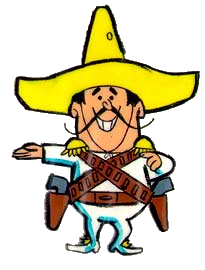As of September 28, 2012, this montage will no longer be available on Pod-O-Matic. It can be heard or downloaded from the Internet Archive at the following address / A compter du 28 septembre 2012, ce montage ne sera plus disponible en baladodiffusion Pod-O-Matic. Il peut être téléchargé ou entendu au site Internet Archive à l'adresse suivante:
http://archive.org/details/SouthOfTheBorder_423
http://archive.org/details/SouthOfTheBorder_423
pcast068 Playlist
=====================================================================
English Commentary – le commentaire français suit
This week we bring our travelog series the Great Escape to a close with a visit “South of the Border”, as they say, or to Latin America more precisely…
From a Canadian perspective, the Canada–United States border, officially known as the International Boundary, is the longest international border in the world shared between the same pair of countries. The terrestrial boundary (including small portions of maritime boundaries on the Atlantic, Pacific, and Arctic coasts, as well as the Great Lakes) is 8,891 kilometres (5,525 mi) long, including 2,475 kilometres (1,538 mi) shared with Alaska. It is Canada's only land border.
However, the United States–Mexico border runs from Imperial Beach, California, and Tijuana, Baja California, in the west to Matamoros, Tamaulipas, and Brownsville, Texas, in the east, and traverses a variety of terrains, ranging from major urban areas to inhospitable deserts. The border's total length is3,169 kilometres (1,969 mi), and is the most frequently crossed international border in the world.
To begin our journey, we cross the US-Mexico border and encounter serenading musicians in folk garb.Mariachi is the best known form of folk music from Mexico. The name refers to the music, the musicians and the bands that play it. Mariachi began as a regional folk style called “Son Jaliscience” in the center west of Mexico originally played only with string instruments and musicians dressed in the white pants and shirts of peasant farmers.
Probably one of the most recognized ballads in mariachi music is Cielito lindo (Lovely Sweet One) – you know it probably as “Ay, ay, ay ay”. Like ion the 1960’s jingle:
Ay, ay, ay, ay! oh, I am dee Frito Bandito. I like Frito's Corn Chips. I love them, I do. I want Frito's corn chips. I'll take them, from you.
Another Mexican favourite is Bésame Mucho, a song written in 1940 by songwriter Consuelo Velázquez and played in our montage by Cuban bandleader Xavier Cugat. According to Velázquez herself, she wrote this song even though she had never been kissed yet at the time, and kissing as she heard was considered a sin.
Another musician of Cuban descent is composer and arranger Aldo Forte, who was long associated woith the US Air Force band based in Fort Langley, VA. His Dance Suite on Spanish and Latin Rythms hits the spot half-way through our journey.
Most of Latin America speaks Spanish, except for Brazil where they speak Portuguese. We retained some Brazilian-inspired music: a few of Darius Milhaud’s Saudades do Brasil and one of Hector Villa-Lobos’Bachianas Brasileiras.
The Bachianas Brasileiras are an attempt by Villa-Lobos to fuse Brazilian folk and popular music on the one hand, and the style of Johann Sebastian Bach on the other, as an attempt freely to adapt a number of Baroque harmonic and contrapuntal procedures to Brazilian music. Most of the movements in each suite have two titles: one "Bachian" (Preludio, Fuga, etc.), the other Brazilian (Embolada, O canto da nossa terra, etc.).
If we keep going south, we find our way to Argentina, which is a surprising melting pot of Spanish and Italian cultures deep in the Southern Hemisphere. Argentine tango is a musical genre of simple quadruple metre and binary musical form, and the social dance that accompanies it. Its lyrics and music are marked by nostalgia, expressed through melodic instruments including the bandoneón. Originated at the ending of the 19th century in the suburbs of Buenos Aires, it quickly grew in popularity and spread internationally. Among its leading figures is Ástor Piazzolla. Piazzolla, in addition to earning a living as a tango artist and performer, took serious music lessons with la grande dame Nadia Boulanger, and many of his works transcend into the concert hall –such as the Concierto de Nácar which I included in today’s montage. Why, even Stravinsky took a shot at the tango…
To bring the journey to a close, we return to Mexico and to American coimposer Aaron Copland – another famous Boulanger pupil. El Salón México is a musical depiction of an eponymous dance hall in Mexico City and even carries the subtitle, "A Popular Type Dance Hall in Mexico City." Although Copland visited Mexico early in the 1930s, he based this tone poem not on songs he heard there, but rather on written sheet music for at least four Mexican folk songs that he had obtained: "El Palo Verde," "La Jesusita," "El Mosco," and "El Malacate." The powerful refrain that appears in the piece three times stems from "El Palo Verde."
I think you will love this music too!
=====================================================================
Commentaire français
Le montage de cette semaine met un terme à notre grande évasion avec un pèlerinage vers le Sud, soit en Amérique Latine.
Pour nous Canadiens, nos voisins du Sud sont les Américains avec qui nous partageons une frontière qui s’étale sur près de 9000 km (si on inclut la bordure de presque 2500 km avec l’Alaska, et on serpente le long des côtes des Grands Lacs. Toutefois, les Américains partagent une frontière avec le Mexique qui fait moins le la moitié de ce parcours (environ 3200 km), divisés entre la frontière avec la Basse Californie ainsi que les sections qui longent la côte Ouest du Golfe du Mexique, incluant la capitale du meurtre Juarez (outre-frontière du hameau d’El Paso au Texas).
Au risque de s’embourber dans les clichés, notre montage s’amorce avec un regard sur la musique folklorique mexicaine, telle qu’incarnée par les mariachis, ces troubadours vêtus de sombreros qui s’accompagnet à la guitare et au violon. Sans doute l’un des airs les plus connus du répertoire mariachi est Cielito lindo (trad. Libre « Ma douce ») qui se ponctue du refrain “Ay, ay, ay, ay”…
Qui parle Amérique Latine parle, bien sûr, des pas de danses qu’on associe étroitement avec les orchestres des grandes salles de danse: le cha-cha, le mambo, la rumba, et j’en passe… Maman avait son musicien préféré, et sa mission était d’enseigner à son pauvre fils tous ces pas de danse dans le salon familial, avec le vieux tourne-disques qui jouait Xavier Cugat. Je n’ai jamais pu maitriser la danse sociale, mais ce vieux Cugat… Je l’ai monté ici avec son orchestre du Waldorf –Astoria de New-York dans la ballade mexicaine Bésame Mucho.
L’an dernier dans un mardi dédié au musée, j’avais proposé une pièce du compositeur Cubano-Américain Aldo Forte, longtemps associé à l’harmonie de concert de l’Armée de l’Air Américaine en Virginie. J’ai monté une autre de ses compositions, une suite de danses d’inspiration hispano-latines.
Le Brésil est un pays particulier en Amérique Latine, principalement car on n’y parle pas espagnol, mais plutôt le portugais. J’ai choisi deux œuvres d’inspiration brésiliennes: une sélection de Saudades do Brasilde Darius Milhaud et une des neuf Bachianas Brasileiras d’Hector Villa-Lobos.
Si l’on descend jusqu’à l’extrêmité Sud du continent, on arrive en Argentine, un pays qui a métissé une culture hispanique avec, entre autres, la culture Italienne et la culture Allemande. Le tango Argentin se distingue par l’omniprésence d’une forme d’accordéon local – le bandoneón - et est teinté de nostalgie beaucoup plus que de l’aspect sensuel de cette danse en quatre temps… Parmi ses plus illustres champions, on compte bien sûr le musicien Argentin et Américain d’adoption, Ástor Piazzolla. Piazzolla, mordu par une vocation tardive, fut l’émule de la grande Nadia Boulanger, ce qui explique pourquoi beaucoup de ses grandes oeuvres sont jouées par nos grands orchestres. C’est le cas du Concierto de Nácar conçu pour neuf musiciens avec orchestre symohonique. J’ai également monté une courte pièce pour petit ensemble de Stravinski, un tango pour orchestre.
Pour conclure cette excursuion, un retour au Mexique, en fait à sa capitale nationale, et une salle de danse que l’Américain Aaron Copland relate dans son poème symphonique El Salón México. Il faut souligner que Copland, contrairement à d’autres compositeurs, ne s’est pas uniquement fié à des souvenirs musicaux, mais a étudié et calqué des airs mexicains qu’il distille à partir de partitions…
Bonne écoute!


No comments:
Post a Comment